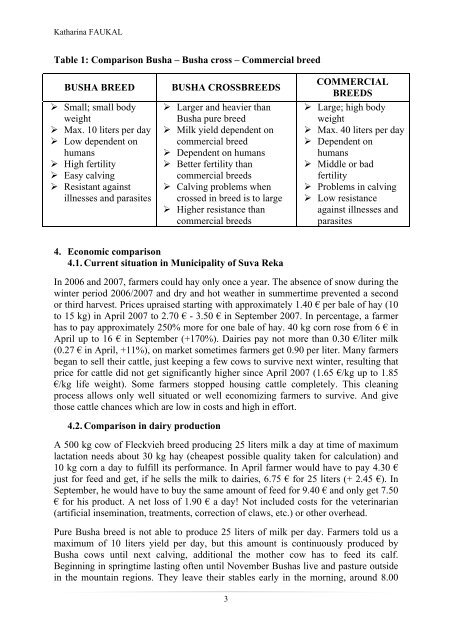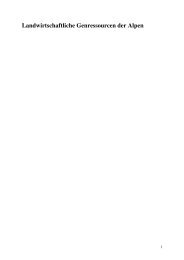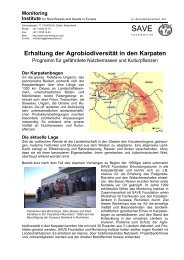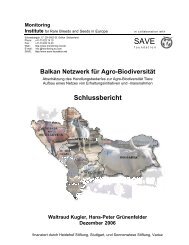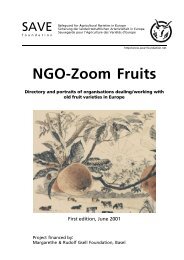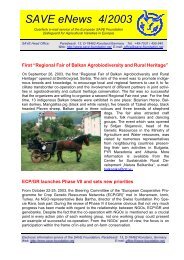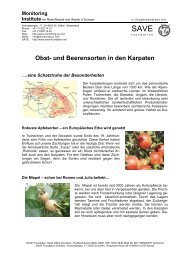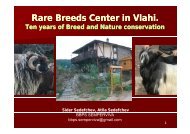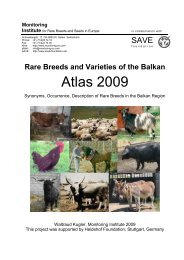The Busha cattle – a breed originated in middle ... - SAVE Foundation
The Busha cattle – a breed originated in middle ... - SAVE Foundation
The Busha cattle – a breed originated in middle ... - SAVE Foundation
Create successful ePaper yourself
Turn your PDF publications into a flip-book with our unique Google optimized e-Paper software.
Kathar<strong>in</strong>a FAUKAL<br />
Table 1: Comparison <strong>Busha</strong> <strong>–</strong> <strong>Busha</strong> cross <strong>–</strong> Commercial <strong>breed</strong><br />
BUSHA BREED BUSHA CROSSBREEDS<br />
Small; small body<br />
weight<br />
Max. 10 liters per day<br />
Low dependent on<br />
humans<br />
High fertility<br />
Easy calv<strong>in</strong>g<br />
Resistant aga<strong>in</strong>st<br />
illnesses and parasites<br />
Larger and heavier than<br />
<strong>Busha</strong> pure <strong>breed</strong><br />
Milk yield dependent on<br />
commercial <strong>breed</strong><br />
Dependent on humans<br />
Better fertility than<br />
commercial <strong>breed</strong>s<br />
Calv<strong>in</strong>g problems when<br />
crossed <strong>in</strong> <strong>breed</strong> is to large<br />
Higher resistance than<br />
commercial <strong>breed</strong>s<br />
4. Economic comparison<br />
4.1. Current situation <strong>in</strong> Municipality of Suva Reka<br />
3<br />
COMMERCIAL<br />
BREEDS<br />
Large; high body<br />
weight<br />
Max. 40 liters per day<br />
Dependent on<br />
humans<br />
Middle or bad<br />
fertility<br />
Problems <strong>in</strong> calv<strong>in</strong>g<br />
Low resistance<br />
aga<strong>in</strong>st illnesses and<br />
parasites<br />
In 2006 and 2007, farmers could hay only once a year. <strong>The</strong> absence of snow dur<strong>in</strong>g the<br />
w<strong>in</strong>ter period 2006/2007 and dry and hot weather <strong>in</strong> summertime prevented a second<br />
or third harvest. Prices upraised start<strong>in</strong>g with approximately 1.40 € per bale of hay (10<br />
to 15 kg) <strong>in</strong> April 2007 to 2.70 € - 3.50 € <strong>in</strong> September 2007. In percentage, a farmer<br />
has to pay approximately 250% more for one bale of hay. 40 kg corn rose from 6 € <strong>in</strong><br />
April up to 16 € <strong>in</strong> September (+170%). Dairies pay not more than 0.30 €/liter milk<br />
(0.27 € <strong>in</strong> April, +11%), on market sometimes farmers get 0.90 per liter. Many farmers<br />
began to sell their <strong>cattle</strong>, just keep<strong>in</strong>g a few cows to survive next w<strong>in</strong>ter, result<strong>in</strong>g that<br />
price for <strong>cattle</strong> did not get significantly higher s<strong>in</strong>ce April 2007 (1.65 €/kg up to 1.85<br />
€/kg life weight). Some farmers stopped hous<strong>in</strong>g <strong>cattle</strong> completely. This clean<strong>in</strong>g<br />
process allows only well situated or well economiz<strong>in</strong>g farmers to survive. And give<br />
those <strong>cattle</strong> chances which are low <strong>in</strong> costs and high <strong>in</strong> effort.<br />
4.2. Comparison <strong>in</strong> dairy production<br />
A 500 kg cow of Fleckvieh <strong>breed</strong> produc<strong>in</strong>g 25 liters milk a day at time of maximum<br />
lactation needs about 30 kg hay (cheapest possible quality taken for calculation) and<br />
10 kg corn a day to fulfill its performance. In April farmer would have to pay 4.30 €<br />
just for feed and get, if he sells the milk to dairies, 6.75 € for 25 liters (+ 2.45 €). In<br />
September, he would have to buy the same amount of feed for 9.40 € and only get 7.50<br />
€ for his product. A net loss of 1.90 € a day! Not <strong>in</strong>cluded costs for the veter<strong>in</strong>arian<br />
(artificial <strong>in</strong>sem<strong>in</strong>ation, treatments, correction of claws, etc.) or other overhead.<br />
Pure <strong>Busha</strong> <strong>breed</strong> is not able to produce 25 liters of milk per day. Farmers told us a<br />
maximum of 10 liters yield per day, but this amount is cont<strong>in</strong>uously produced by<br />
<strong>Busha</strong> cows until next calv<strong>in</strong>g, additional the mother cow has to feed its calf.<br />
Beg<strong>in</strong>n<strong>in</strong>g <strong>in</strong> spr<strong>in</strong>gtime last<strong>in</strong>g often until November <strong>Busha</strong>s live and pasture outside<br />
<strong>in</strong> the mounta<strong>in</strong> regions. <strong>The</strong>y leave their stables early <strong>in</strong> the morn<strong>in</strong>g, around 8.00


